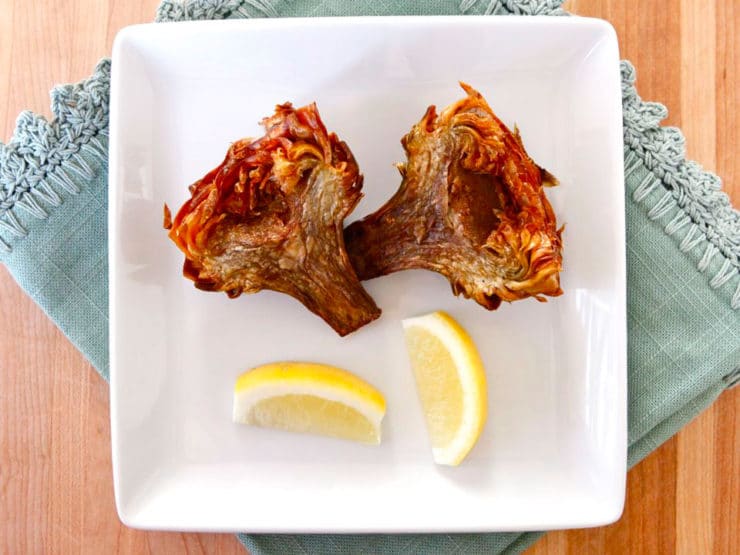
Italians, particularly Jewish Italians, are somewhat responsible for pushing artichokes into global popularity. In his Encyclopedia of Jewish Food, historian Gil Marks explains that Italian Jews favored artichokes early on, while non-Jewish Italians showed distaste for them, often referring to them as “the Jewish vegetables.” In the 1500s, Pope Paul IV forced all the Jews in Rome to live within a secluded ghetto where food and water were scarce. Out of necessity, frying over an open fire became a popular cooking method. Artichokes, which were one of the few plentiful food sources, were eaten fried. Over time, the artichoke gained favor with all Italians, including the Medicis of Florence. Catherine de Medici, who was known for her insatiable appetite, brought artichokes to France when she married Henry II. Until this time, they were considered something of a novelty.
Artichokes are my favorite vegetable, and may very well be my favorite food. As you might imagine, I’ve cooked and eaten them in a multitude of ways. The most surprising preparation I’ve ever tasted, and perhaps the most delicious, was first served to me at an Italian restaurant in Miami Beach, Florida. This dish, known as carciofi alla giudea or artichokes “Jewish style,” has roots in Pope Paul IV’s Jewish ghetto. In Italy the dish is usually made with Romanesco artichokes, which are purple, more tender and less thorny than the globe artichokes commonly available in America. To replicate the texture of the Romanesco version of this dish, I took a tip from the restaurant’s chef and steamed my globe artichokes lightly before frying. I also split the artichokes in half, which allows them to cook faster and more evenly (it also makes them easier to eat!). I sliced the leaves close to the heart, which resulted in a pretty flower-like crown on top. The result was divine—a perfectly crisp golden exterior with a tender, slightly sweet inner heart. It’s a flavor symphony. Mangia!
Recommended Products:
We are a participant in the Amazon Services LLC Associates Program, an affiliate advertising program designed to provide a means for us to earn fees by linking to Amazon.com and affiliated sites. As an Amazon Associate I earn from qualifying purchases.
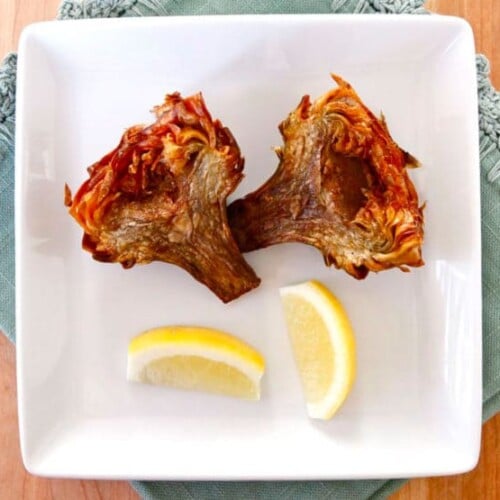
Jewish Fried Artichokes
Ingredients
- 4 artichokes (large, not baby)
- Olive oil for frying
- Salt and pepper
- 4-5 fresh lemons for preparation and serving
NOTES
Instructions
- Prepare a large bowl of ice water. Squeeze two lemons into the bowl of water, stir, then throw in the squeezed lemon halves. This lemon water will keep your artichokes fresh and green till you’re ready to fry them. Keep a couple of fresh lemon halves on hand as you prep. Rinse your artichokes under cold water. Pat them dry with a clean kitchen towel or paper towel. With kitchen shears or sharp scissors, remove the thorny tips from the leaves. For each artichoke, remove the bitter, fibrous end of the stem with your knife, leaving about 1 1/2 inches of stem attached to the artichoke.

- Use a serrated peeler or paring knife to peel the outer skin from the remaining stem. The stem has a more bitter taste than the rest of the artichoke; removing the skin helps to take away some of the bitterness. Rub the peeled stem with fresh lemon to keep it from browning.

- Peel off 5-6 layers of external leaves from the artichoke, snapping off the leaves and setting them aside, till you reach an inner layer of leaves that are fresh looking and white at the base.

- With a serrated knife or sharp chef’s knife, slice the artichoke horizontally about ¾ inch above the base (heart) to remove the pointy top of the artichoke, leaving a flat crown of leaves on the base of the artichoke while exposing the inner purple leaves.

- Slice the artichoke in half lengthwise, splitting the stem and heart in half vertically to reveal the inner fuzzy choke.

- Scoop out the fuzzy spines and purple leaves from each artichoke half with a melon baller, leaving behind two hollowed out halves of heart, each with a small crown of flat leaves.

- You may wish to place the artichoke halves under cold running water to remove any stubborn bits of fuzzy choke.Rub the heart with lemon, then place it in the bowl of lemon water. Repeat process with the other remaining artichokes.

- When ready to cook, remove the artichoke halves from the lemon water. Pour the lemon water and juiced lemon halves into a large pot; you will need about 1 ½ inches of water, so if you don’t have enough, add more water to top it off. Place a steamer basket inside the pot and bring water to a boil. Place the cleaned artichoke halves into the steamer basket and cover the pot with a lid. Reduce heat to medium.

- Let the artichokes steam for 15-20 minutes till a knife or fork can be inserted easily into the thickest part of the stem. You want the artichokes to be lightly steamed and a bit tender, but still firm—they should only be partially cooked.

- Place the steamed artichoke halves onto a layer of paper towels and let them drain. Heat 1 inch of olive oil to around 375 degrees F, hot enough for frying but not so hot that it smokes. While oil is heating, sprinkle the artichoke halves with salt and pepper, making sure to sprinkle inside the layers of leaves as well.

- Place the artichokes gently into the heated oil and let them fry for about 15 minutes, using a pair of tongs to turn them once halfway through cooking, till artichokes are golden brown and the leaves are crisp.

- Remove from the oil and let them drain on paper towels or a wire rack. Serve fried artichokes warm with fresh sliced lemon wedges.

Nutrition

tried this recipe?
Let us know in the comments!
Note: Strictly kosher Jews have their own guidelines for cleaning and consuming artichokes, which differ from the tutorials that appear on my site.
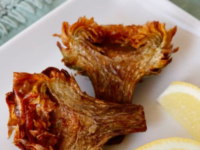
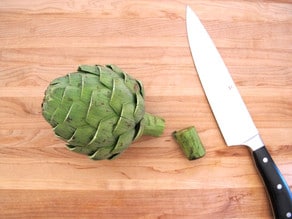
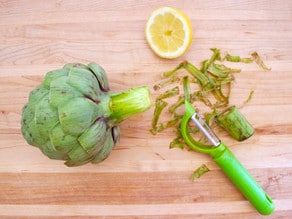
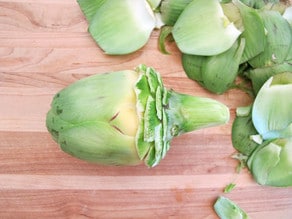
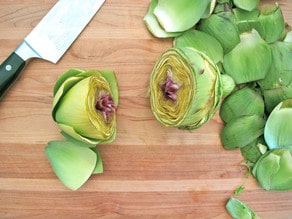
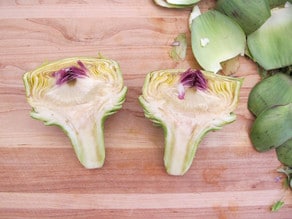
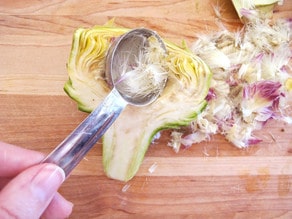
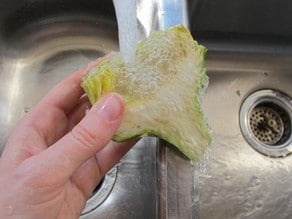
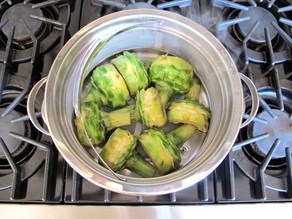
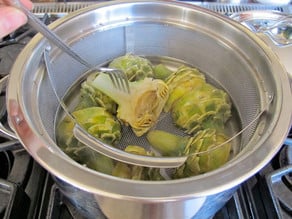
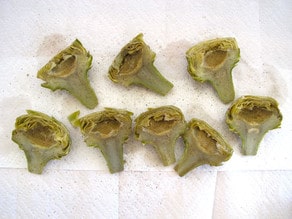
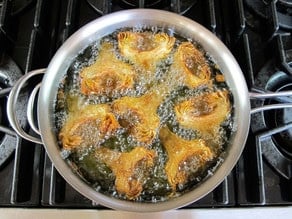



375 degrees burns the artichokes. I have digital thermometers and advanced kitchen equipment. The heart was OK, but the remaining small leaves were burnt.
I also don’t 7nderstand why you suggest grooming the pointy tips, only to instruct, in practically the next step, to cut off all the leaf tops. Pretty much not sensible.
I’m sorry to hear you had this experience. May I ask if you used full sized artichokes, or small ones? The smaller ones that are available now in season would certainly overcook at this temperature. The tip about grooming the pointed tips is to keep you from stabbing yourself as you groom and peel away the leaves. The points are extremely sharp. If you are wearing protective gloves you can skip this step to save time.
I love your writing style, the pix and your detailed instructions. I will be trying this recipe tomorrow as my artichoke plants are going insane! I have eaten artichokes once in this style in a restaurant, but am very much looking forward to making it tomorrow on my farm, with my own fresh picked artichokes and lemons. I’ll let you know what I think. BTW… I am lucky enough to live in Michoacan, Mexico… and the artichokes love the climate. I planted seeds last spring… we had a nice feed last year… but this spring… insane is the only word. I need to find new recipes or buy a freezer!
Lots of artichoke recipes on this site, Brent– use the search box and you’ll find more ideas 🙂
Your pictures are so nice and useful. I’m impressed. Thanks.
Have enjoyed pickled artichokes but this looks much more interesting.
Want to serve for a lunch. What can be done ahead.
You can steam them ahead of time, then keep them in the fridge till you’re ready to fry. Sprinkle with salt and pepper just before frying.
Thank you for your detailed written and pictorial of preparing artichokes. Made it simple and easy to do. i never new how to prepare them properly and quickly.
One of my favorite meals is chicken baked with artichokes. Lots of artichokes in cans and jars available, but fresh are best in this dish.
Can’t wait to try these fried ones!
I was in Italy this year and had read about the wonderful artichokes in the Jewish Quarter of Rome. Went there and of course had to order them. To bad I had to share with my friends. Could have eaten them all by myself. Walked past the kitchen and saw them preparing them. They were probably the best thing I had on my trip. Will try to make them.
When Joe and I went to Rome a few years ago, one of our stops was of course, the Jewish Ghetto! We had lunch at this spot where we saw this older gentleman sitting outside and peeling artichokes like no tomorrow! He sat on this dinky chair and you saw piles and piles of artichoke leaves! Of course we ordered fried artichokes and I have not had them since! Thanks for re-living our memory 🙂
I have never seen the fried ones! But I ate some good artichoke dishes in Rome and loved it! I am sure it is worth to deal with all that thorny leaves!
Hope your summer is going well 🙂